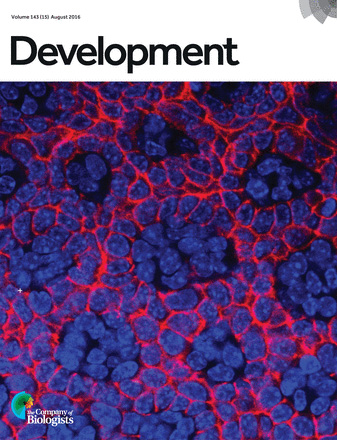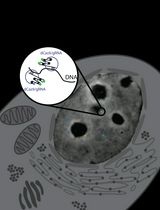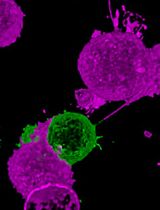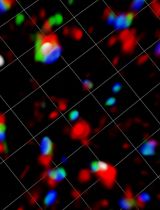- EN - English
- CN - 中文
Live-cell Migration Assays to Study Motility of Neural and Glial (Oligodendrocyte) Progenitor Cells
利用活细胞运动分析研究神经和胶质(少突胶质细胞)祖细胞运动
发布: 2019年06月20日第9卷第12期 DOI: 10.21769/BioProtoc.3275 浏览次数: 5128
评审: Giusy TornilloSubhamoy DasZe Yang
Abstract
Cell motility has been extensively studied in in vitro models using fibroblasts and keratocytes, but the cell type-specific mechanisms underlying migration of lineage- or disease-specific cells, such as neural and glial progenitor cells, remain an active field for investigation. The migrating neural and glial progenitor cells contribute to the development, tissue repair and tumor invasion in the central nervous system (CNS). Cell migration is a highly dynamic process which relies on membranous protrusions to assemble, extend, disassemble and retract. In the CNS, the motility of neural and glial progenitor cells is affected by various cell-autonomous and non-cell-autonomous mechanisms such as signaling molecules, actin and microtubule interactions, and environmental cues. Here, we described a live-cell migration assay for use in the assessment of neural and glial progenitor cell migration. We first will demonstrate the procedures for isolating and culturing neural and glial progenitor cells. Next, we will demonstrate the acquisition of time-lapse images using phase contrast microscopy, the methods for quantification and the analyses of various motility parameters including speed, velocity, straightness and leading-edge dynamics. This method allows researchers to dissect the mechanisms of cell motility in response to different environmental cues, such as chemoattractive and repulsive signals, matrix adhesiveness and stiffness. This assay also allows researchers to study migration of pharmacologically and genetically manipulated cells.
Keywords: Cell migration assays (细胞运动分析)Background
Cell migration plays a key role in many physiological (morphogenesis, tissue repair, regeneration) and pathological (tumor metastasis, atherosclerosis) processes. It is a highly orchestrated multistep process, which requires dynamic interactions between cells and the extracellular cues such as chemokines and signals from the extracellular matrix. In response to the extracellular cues, cells acquire a polarized morphology. Cell polarization requires delicate regulation of microtubule and actin polymerization for asymmetrical distribution of signaling molecules, cytoskeletal proteins, and directional vesicle trafficking. At the leading edge, actin polymerization drives the extension of membrane protrusions, such as lamellipodia (facilitating focal adhesion formation to anchor the protrusion) and filopodia (sensing the environment). In order to move forward, cells have to disassemble adhesions on the trailing edge and retract the trailing end, which require coordination of microtubule and actin networks (Palazzo and Gundersen, 2002; Wehrle-Haller and Imhof, 2003; Etienne-Manneville, 2004). Disruption of cell migration and polarization would affect the process of neurogenesis, and may lead to neurodevelopmental disorders or brain tumor progression (Rakic, 2003; Götz and Huttner, 2005; Taylor et al., 2005; Wang et al., 2016).
Neural and glial progenitor cells are the major proliferating and migrating cells in the CNS, and are crucial for the development of neurological functions of an organism. Neural and glial progenitor cells have also been implicated as the cell origin of gliomas. Indeed, glioma migration and infiltration recapitulate key aspects of glial progenitor cell migration during development. Specifically, glioma cells, similar to glial progenitors in the developing CNS, bear a unipolar or a bipolar morphology with a leading process and migrate along white matter tracts and blood vessels (Cayre et al., 2009).
In this report, we will introduce a live-cell migration assay and the analytical methods which allow us to study cell motility in the presence of inhibitors or different environmental cues. We will first demonstrate how to isolate and culture neural and glial progenitor cells. Next, we will demonstrate our approach to capturing time-lapse images, and to tracking migrating cells for quantification. The live-cell migration assay can be applied to neural and glial progenitor cells as well as to tumor spheres. This assay can also be used to study cell motility in response to inhibitors, different extracellular substrates and stiffness, attractive or repulsive cues, as well as changes in the electrical field (Li et al., 2015) without optimizing the duration of migration and final detection.
Materials and Reagents
- 10 cm Petri dish (Thermo Fisher Scientific, catalog number: 172931)
- 15 cm Petri dish (Thermo Fisher Scientific, catalog number: 168381)
- 15 ml conical tube (Thermo Fisher Scientific, catalog number: 339651)
- 40 μm cell strainer (Argos Technologies, catalog number: TC1040-A)
- 6-well plate (Thermo Fisher Scientific, catalog number: 140675)
- Glass bottom dish (MatTek, catalog number: P35G-1.5-14-C)
- 1 ml pipette
- Serological pipet
- Timed-pregnant mouse embryos
Note: Neural and glial progenitor cells can be isolated from embryonic day (E) 13.5 to E15.5 embryos, a stage where early and active neurogenesis occurs. Note that, during this stage, progenitor cells evolve rapidly between proliferative expansion and cell lineage differentiation, Therefore, it is critical to select embryos from similar developmental time points in experiments where comparison between progenitor cells from different embryos (e.g., certain genetic models, different treatment groups) are unavoidable. - Ethanol
- Hanks’ balanced salt solution (HBSS) (Thermo Fisher Scientific, catalog number: 14025092)
- DMEM/F12 (Thermo Fisher Scientific, catalog number: 11330032)
- Insulin (Sigma, catalog number: I0516)
- N2 supplement (Thermo Fisher Scientific, catalog number: 17502048)
- B27 supplement (Thermo Fisher Scientific, catalog number: 17504044)
- Epithelial growth factor (EGF) (Peprotech, catalog number: AF-100-15)
- Basic fibroblast growth factor (bFGF) (Peprotech, catalog number: AF-100-18B)
- DMSO (EMD Millipore, catalog number: S-002-D)
- Dulbecco’s PBS (DPBS), no calcium, no magnesium (Thermo Fisher Scientific, catalog number: 14190144)
- Accutase (Thermo Fisher Scientific, catalog number: A1110501)
- Platelet-Derived Growth Factor AA (PDGF-AA) (Peprotech, catalog number: AF-100-13A)
- Poly-L-ornithine (PLO) (Sigma, catalog number: P4957)
- Laminin (Thermo Fisher Scientific, catalog number: 23017015)
- Dulbecco’s PBS, with calcium and magnesium (Thermo Fisher Scientific, catalog number: 14040133)
- Neural Growth Medium (NGM) (see Recipes)
- Oligosphere Medium (OM) (see Recipes)
Equipment
- Pipettes
- Micro scissor (Ted Pella, catalog number: 1346)
- Tweezer (Ted Pella, catalog number: 525)
- Dressing forceps (Ted Pella, catalog number: 5002-42)
- Dissection sharp/blunt scissors (Ted Pella, catalog number: 1329)
- Hemocytometer
- Centrifuge
- Inverted live-cell imaging system, connected to an incubator with a controlled temperature (temperature module) and CO2 module such as EVOSTM FL Auto (Thermo Fisher Scientific)
Software
- Chemotaxis software (ibidt, https://ibidi.com/44-software-and-image-analysis)
- ImageJ (https://imagej.nih.gov/ij/index.html)
Procedure
文章信息
版权信息
© 2019 The Authors; exclusive licensee Bio-protocol LLC.
如何引用
Chen, C., Chou, F. and Wang, P. (2019). Live-cell Migration Assays to Study Motility of Neural and Glial (Oligodendrocyte) Progenitor Cells. Bio-protocol 9(12): e3275. DOI: 10.21769/BioProtoc.3275.
分类
神经科学 > 细胞机理 > 细胞分离和培养
细胞生物学 > 细胞运动 > 细胞迁移
细胞生物学 > 细胞成像 > 活细胞成像
您对这篇实验方法有问题吗?
在此处发布您的问题,我们将邀请本文作者来回答。同时,我们会将您的问题发布到Bio-protocol Exchange,以便寻求社区成员的帮助。
提问指南
+ 问题描述
写下详细的问题描述,包括所有有助于他人回答您问题的信息(例如实验过程、条件和相关图像等)。
Share
Bluesky
X
Copy link












